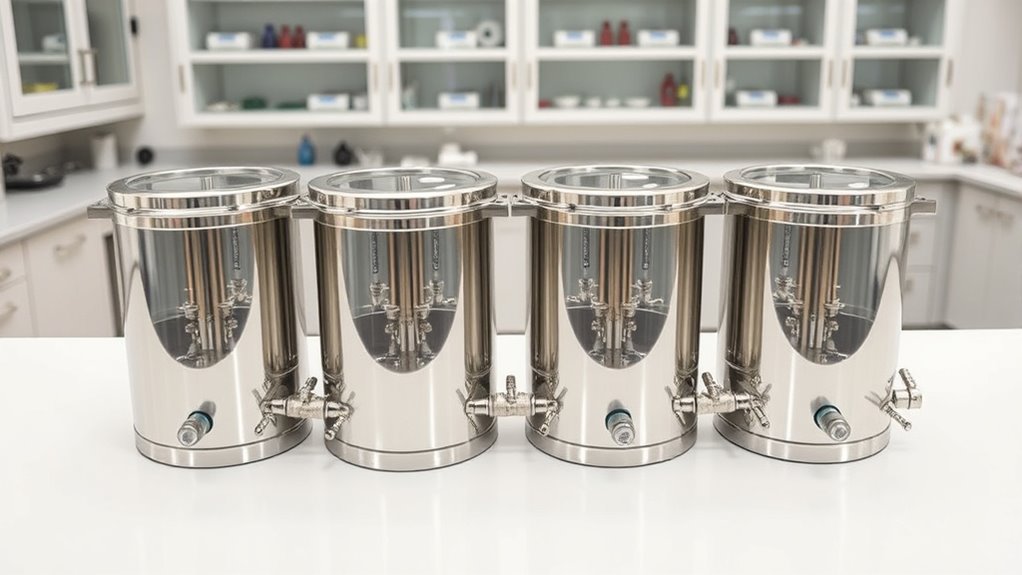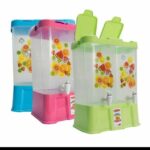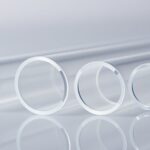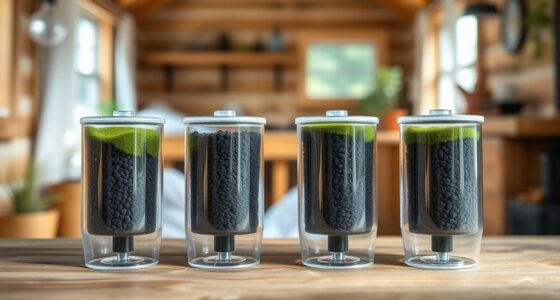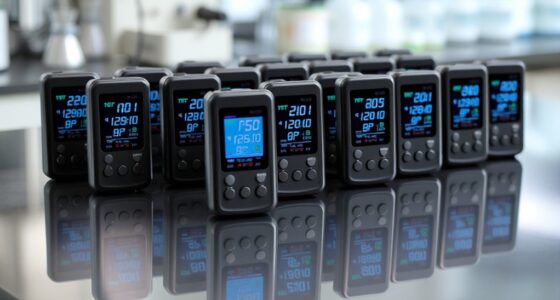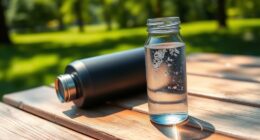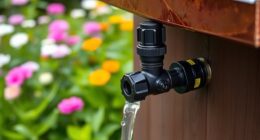If you’re looking for the best stainless steel hydrolysis cells for reliable lab testing, I recommend considering options like the 100ml autoclave reactor with PTFE lining, which handles high temperatures and pressures reliably. Additionally, I’d look at durable models made from thickened 304 stainless steel, ensuring corrosion resistance and safety features like sealed locking mechanisms. For versatile applications, units with easy maintenance and excellent sealing are ideal. Keep exploring further to discover more options that suit your specific needs.
Key Takeaways
- Choose hydrolysis cells made from thickened 304 or 316 stainless steel with PTFE linings for corrosion resistance.
- Ensure they support temperatures up to 220°C and pressures around 3 MPa for demanding hydrothermal reactions.
- Prioritize models with reliable sealing, threaded locking mechanisms, and safety features like pressure relief valves.
- Opt for units with smooth surfaces, easy maintenance access, and durable construction for long-term reliability.
- Select equipment certified to industry standards (e.g., ASTM A240) to guarantee quality, safety, and performance.
Hydrothermal Autoclave Reactor, 100ml, Stainless Steel
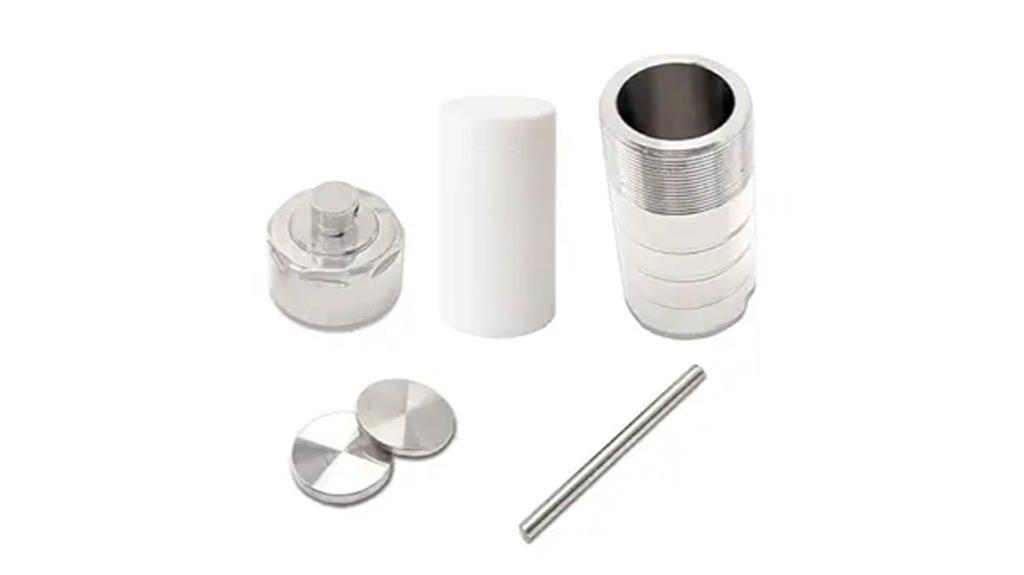
If you’re conducting small-scale hydrothermal experiments or research, the 100ml stainless steel hydrothermal autoclave reactor is an excellent choice because of its durable construction and reliable sealing. Made from thickened 304 stainless steel with a PTFE lining, it can handle temperatures up to 220°C and pressures up to 3 MPa. Its corrosion-resistant design makes it perfect for acids and alkalis. The smooth threading ensures easy locking and releasing, while the robust sealing prevents leaks. Compact and safe, this reactor is ideal for synthesis, chemical reactions, and laboratory testing, offering dependable performance in a small, efficient package.
Best For: small-scale researchers and laboratory professionals conducting hydrothermal synthesis, chemical reactions, or testing with a need for durable, corrosion-resistant autoclave equipment.
Pros:
- Made of thickened 304 stainless steel with PTFE lining for high durability and corrosion resistance
- Capable of handling temperatures up to 220°C and pressures up to 3 MPa, suitable for demanding hydrothermal processes
- Easy to operate with smooth threading and reliable sealing to prevent leaks
Cons:
- Limited to a maximum volume of 100ml, not suitable for large-scale applications
- Requires thorough cleaning after each use to prevent corrosion and maintain sealing integrity
- Operating at high temperatures and pressures necessitates careful handling and adherence to safety procedures
IVERMIT 12 || mg |||| 100Tablets || 99% Lab
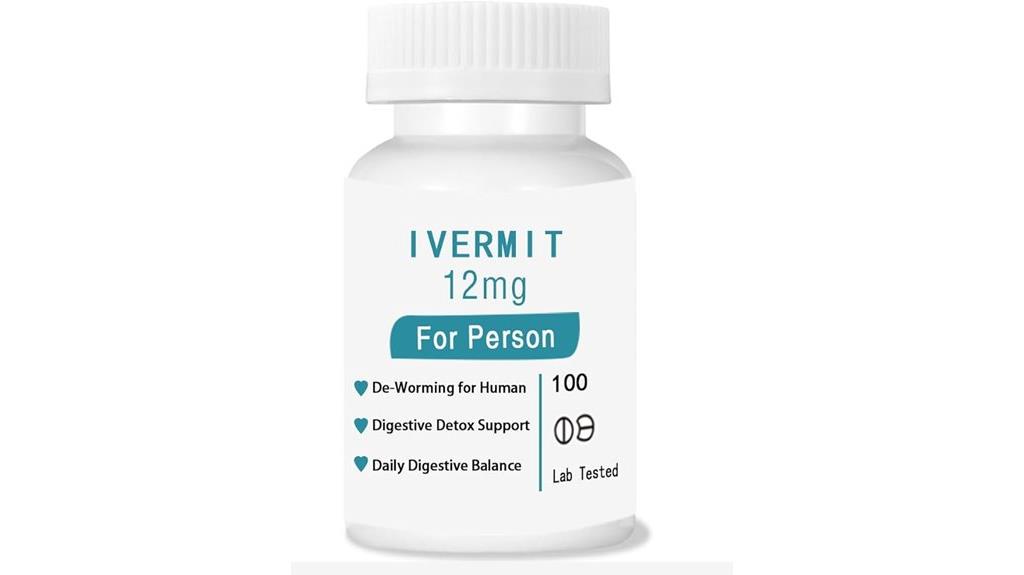
Stainless Steel Hydrolysis Cells are ideal for laboratories and industrial settings that demand durable, corrosion-resistant equipment. I want to highlight IVERMIT 12 mg, which comes in a pack of 100 tablets with 99% lab-grade purity. Each tablet contains 12of active ingredient, ensuring consistent potency. It’s made with non-GMO, gluten-free ingredients, and stored properly in a cool, dry place away from sunlight. The high-quality formulation guarantees effective results without reported side effects. While there are no specific dosage instructions, its reliability and purity make it a trusted choice for lab testing and research applications.
Best For: researchers and laboratory professionals seeking high-purity, reliable tablets for testing and experimental purposes.
Pros:
- High purity (99% lab-grade quality) ensures consistent and accurate results
- Contains a precise 12 mg active ingredient per tablet for reliable dosing
- Made with non-GMO, gluten-free ingredients, ensuring safety and quality
Cons:
- No specific dosage instructions provided, which may require additional guidance
- Intended primarily for lab use, not suitable for direct human consumption without proper medical guidance
- Storage conditions require a cool, dry place away from sunlight, which may be inconvenient for some users
High Purity Hydrogen Generator (0-300ml/min, 110V)

The High Purity Hydrogen Generator (0-300ml/min, 110V) is ideal for laboratories that require a reliable source of ultra-pure hydrogen, as it produces gas at 99.999% purity through water electrolysis. Its adjustable flow rate, from 0 to 300ml/min, allows precise control tailored to specific experiments, with a digital LED display for easy monitoring. The device is simple to operate, featuring a user-friendly switch and built-in safety features that prevent backflow, ensuring safe, maintenance-free operation. Its compact, quiet design, reinforced with durable polycarbonate piping, makes it perfect for confined lab spaces while providing stable, consistent hydrogen production.
Best For: laboratories requiring a reliable, high-purity hydrogen source for precise experimental applications.
Pros:
- Produces 99.999% pure hydrogen via water electrolysis for high-quality gas needs
- Adjustable flow rate (0-300ml/min) with digital LED display for precise control and monitoring
- Compact, quiet, and durable design suitable for confined lab spaces with safe, maintenance-free operation
Cons:
- Limited to a maximum flow rate of 300ml/min, which may not suit larger-scale needs
- Operates solely on 110V power supply, restricting use in regions with different electrical standards
- May require regular calibration to maintain optimal electrolysis performance
Upgraded Hydrogen Water Bottle Generator Portable (14oz, Grey)
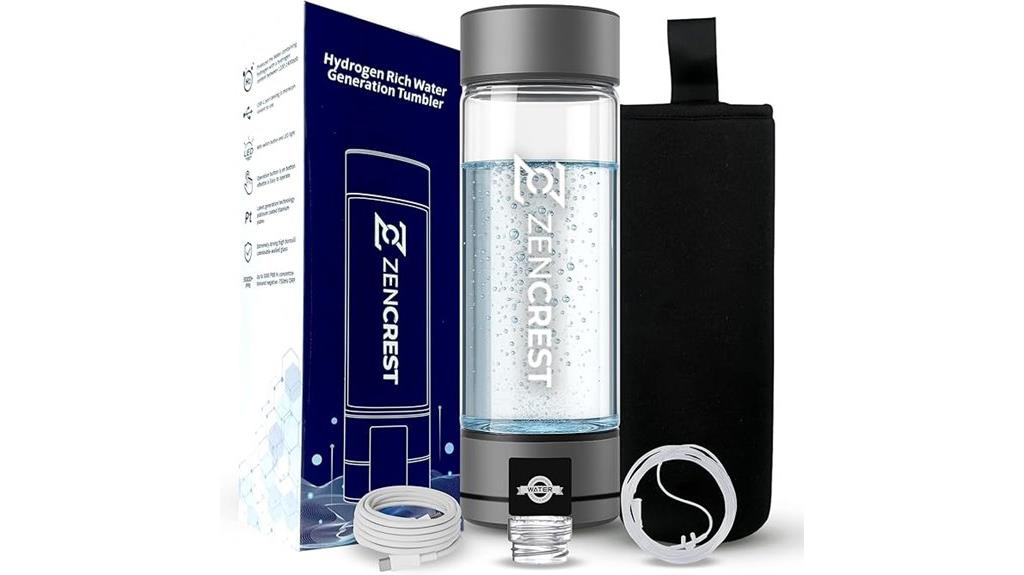
Designed for active individuals who want reliable, high-quality hydrogen generation on the go, the Upgraded Hydrogen Water Bottle Generator features advanced stainless steel hydrolysis cells that guarantee consistent performance. Its 6th-generation SPE/PEM technology produces up to 3000PPB hydrogen-rich water instantly. The stylish, durable design combines high borosilicate glass and robust aluminum, making it perfect for gym, office, or outdoor adventures. With a convenient 5-minute cycle, automatic backwash, and a portable 4000mAh battery, it offers quick, dependable hydration anywhere. The full accessory kit, including a carry bag and fixture for bottled water, ensures versatility and ease of use wherever life takes you.
Best For: active individuals seeking reliable, high-quality hydrogen-rich water and hydrogen gas generation on the go for hydration, wellness, and convenience.
Pros:
- Advanced 6th-generation SPE/PEM technology ensures consistent, high PPB hydrogen production.
- Portable design with a durable, stylish combination of high borosilicate glass and aluminum, ideal for travel and daily use.
- Includes a full accessory kit with a carry bag, fixture for bottled water, and automatic backwash for easy maintenance.
Cons:
- Battery life (approximately 50 uses per full charge) may require frequent recharging during intensive use.
- The device’s size and weight might be less convenient for very compact or minimalist travel setups.
- Some users may find the 5-minute electrolysis cycle slightly longer compared to quicker hydration options.
Factors to Consider When Choosing a Stainless Steel Hydrolysis Cell
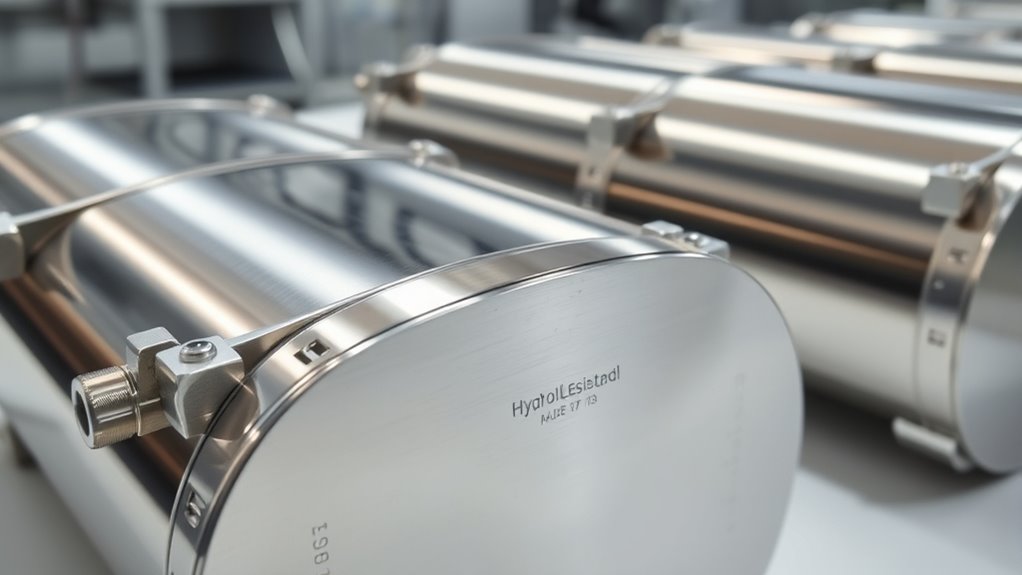
When selecting a stainless steel hydrolysis cell, I look at key factors like material quality standards and corrosion resistance to guarantee durability. I also consider the temperature tolerance and pressure capacity to match my specific application needs. Ultimately, I pay attention to sealing and locking mechanisms for safety and performance.
Material Quality Standards
Choosing a stainless steel hydrolysis cell requires careful attention to material quality standards to guarantee safety, durability, and performance. I look for cells that meet industry certifications like ASTM A240 or use 304/316 stainless steel grades, which ensure excellent corrosion resistance and strength. High-quality stainless steel should have low carbon content to reduce risks of carbide precipitation and intergranular corrosion during high-temperature use. A smooth surface finish, with a Ra value below 0.8 micrometers, is essential for easy cleaning and minimizing contamination. I also consider whether the material can withstand aggressive chemicals and high pressure without leaching or degrading over time. Plus, rigorous testing for mechanical strength and thermal cycling resistance confirms the cell’s safety and reliable operation.
Corrosion Resistance Level
Have you ever wondered how to guarantee your stainless steel hydrolysis cell withstands aggressive chemicals and harsh conditions? The key is choosing a cell with an appropriate corrosion resistance level, often rated by standards like ASTM or ANSI. The stainless steel grade matters—304 offers good resistance, but 316 is superior, especially against chlorides and acids. A higher resistance ensures your cell remains durable and performs consistently over time, preventing deterioration of structural integrity. You can also enhance corrosion protection with linings like PTFE, ideal for highly aggressive chemicals. Regular maintenance and cleaning are essential to preserve these properties. Selecting a cell with the right corrosion resistance level ensures reliable performance and extended lifespan, making it a crucial factor in your decision-making process.
Temperature Tolerance Range
Understanding the temperature tolerance range of a stainless steel hydrolysis cell is essential because operating outside this range can compromise its integrity and performance. Typically, these cells handle temperatures from ambient up to around 220°C, depending on their construction and materials. Stainless steel 304, for example, can withstand much higher temperatures—up to 870°C in continuous service—but practical limits are much lower to guarantee safety and material longevity. Staying within the specified temperature range preserves the steel’s corrosion resistance and mechanical strength, which are critical during hydrolysis reactions. Exceeding the maximum temperature can lead to deformation, seal failure, or corrosion, ultimately damaging the cell. Proper temperature control ensures safe operation, peak reaction efficiency, and prolongs the lifespan of the hydrolysis cell.
Pressure Handling Capacity
Ever wondered what determines a stainless steel hydrolysis cell’s ability to withstand high pressures? It mainly depends on its maximum rated pressure, usually between 2 to 3 MPa for standard models. Thicker walls and reinforced locking mechanisms play a crucial role, allowing the cell to resist deformation or failure under elevated pressures. The design of the sealing system, including gaskets and threads, is equally important in maintaining pressure integrity and preventing leaks during intense reactions. Additionally, the operational pressure limit should align with the specific chemical reactions and temperature conditions you’re working with, ensuring safety and efficiency. Incorporating safety features like pressure relief valves is essential for managing unexpected pressure surges and protecting the cell’s structural integrity during demanding laboratory processes.
Sealing and Locking Mechanisms
The ability of a stainless steel hydrolysis cell to operate safely under high pressure relies heavily on its sealing and locking mechanisms. Effective seals, like PTFE gaskets, prevent gas leaks and ensure process integrity, even with corrosive chemicals. Locking mechanisms, such as threaded lids and reinforced rods, secure the chamber during high-temperature reactions, making operation safer and more straightforward. Proper design of these components allows for uniform tightening, which helps distribute pressure evenly and maintains the seal’s integrity. Regular inspection and maintenance are essential to catch any wear or damage that could lead to leaks or safety hazards. When selecting a hydrolysis cell, prioritize robust sealing and locking features to ensure safety, reliability, and consistent performance over time.
Ease of Maintenance
When choosing a stainless steel hydrolysis cell, ease of maintenance should be a top priority because it directly impacts ongoing safety and efficiency. I look for models with smooth, accessible surfaces and joints, which make cleaning more thorough and prevent residue buildup. Removable or easily cleanable parts, like sealing gaskets and electrodes, simplify routine maintenance. I also consider designs with corrosion-resistant features, such as PTFE linings, to reduce degradation and cleaning frequency. Regular inspection of seal lines, threaded connections, and welds is essential to maintain integrity and prevent leaks. Additionally, clear operating instructions and maintenance guidelines help ensure proper upkeep, extending the cell’s service life. Prioritizing these factors makes maintenance straightforward, safe, and efficient over the long term.
Compatibility With Reactions
Choosing a stainless steel hydrolysis cell that’s compatible with your reactions requires careful consideration of several factors. First, I verify the cell’s chemical resistance matches the reagents I plan to use, preventing corrosion or degradation. I also confirm that the cell’s temperature and pressure limits align with my reaction conditions to avoid safety hazards or equipment failure. Proper mixing or agitation capabilities are essential if my reactions require uniformity, so I ensure the design supports this. Additionally, I check that the sealing and gasket materials are compatible with the chemicals involved to prevent leaks or contamination. Ultimately, I consider the size and volume capacity to match my reaction scale, ensuring efficiency and safety throughout the process.
Frequently Asked Questions
What Maintenance Is Required for Stainless Steel Hydrolysis Cells?
Maintaining stainless steel hydrolysis cells is quite straightforward and keeps them performing at their best. I regularly clean them with mild detergents and rinse thoroughly to prevent residue buildup. Checking for any signs of corrosion or damage is essential, and I make sure all seals and connections are secure. Occasionally, I perform a deep clean with specialized solutions to maintain their integrity and ensure reliable, consistent results every time.
How Long Do Stainless Steel Hydrolysis Cells Typically Last?
Stainless steel hydrolysis cells usually last between 5 to 10 years, depending on usage and maintenance. I’ve found that proper cleaning, avoiding harsh chemicals, and regular inspections considerably extend their lifespan. If you handle them carefully and perform routine checks for corrosion or wear, you can maximize their durability. Ultimately, the quality of the steel and how diligently you maintain the cells play key roles in their longevity.
Are There Size Options Beyond 100ML for These Cells?
Absolutely, there are size options beyond 100ml—imagine a hydrolysis cell the size of a small bucket! While most standard cells max out around 100ml, some manufacturers offer larger custom options for specialized needs. I’ve seen setups with cells that go up to a liter or more, perfect for bigger experiments. So yes, if you need something bigger, it’s definitely possible—just be prepared for a bigger investment!
Can Stainless Steel Hydrolysis Cells Be Used With Corrosive Chemicals?
Yes, stainless steel hydrolysis cells can be used with corrosive chemicals, but I always recommend checking the specific grade of stainless steel. For highly corrosive substances, I prefer cells made from more resistant alloys like 316L or 904L. Proper sealing and compatibility testing are essential to prevent leaks or damage. When used correctly, these cells provide reliable, long-lasting performance even with aggressive chemicals.
What Safety Features Are Integrated Into These Hydrolysis Cells?
Think of these hydrolysis cells like a fortress—built with safety in mind. They include features such as pressure relief valves, which prevent over-pressurization, and secure seals to avoid leaks of corrosive chemicals. Additionally, they’re constructed with corrosion-resistant stainless steel and often have grounding points to prevent static buildup. These safety measures guarantee not just reliable testing but also a safer environment for everyone working with them.
Conclusion
Choosing the right stainless steel hydrolysis cell is like finding the perfect key to open reliable, efficient lab results. With options tailored for different needs, you can trust that each of these top picks will serve as a steadfast partner in your testing endeavors. Remember, the right cell isn’t just a tool—it’s the cornerstone of precision in your scientific journey, ensuring your experiments sail smoothly through every tide of discovery.
